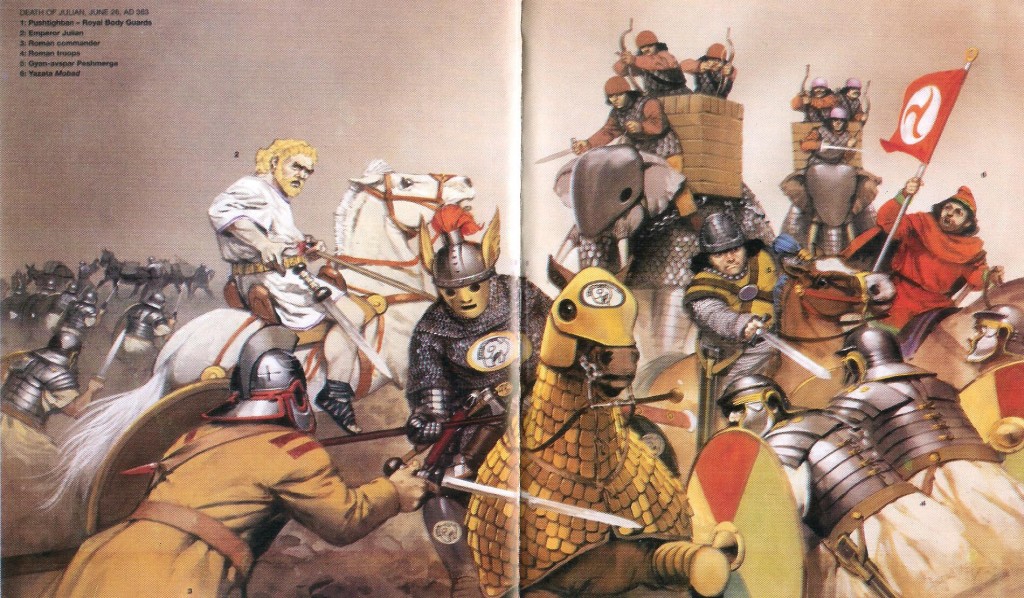The British Military History Monthly Journal has published an article by Kaveh Farrokh on the Sassanian army of ancient Iran (Spah):
Farrokh, K. (2014). Soldiers of the Sassanian Empire: Rome’s unbeaten rival in the East. Military History Monthly, November Issue 50, pp.62-66, 68.
As noted in the beginning of the article: “With all its success and brilliance in Europe, the Mediterranean, and North Africa, Rome never conquered the Spah (‘Military’) of the Sassanian Empire. Roman Emperors such as Alexander Severus, Valerian, and Julian the Apostate tried and failed to subjugate Persia. Thanks to European and Iranian military historians, as well as Classical, Iranian, and Islamic sources, we now have a clearer picture of the Sassanian Spah.” [CLICK TO ENLARGE]- Emperor Julian is killed during his failed invasion of Sassanian Persia in June 26, 363 AD. Above is a recreation of Sassanian Persia’s elite cavalry, the Savaran, as they would have appeared during Julian’s failed invasion. Note the heavily armored Sassanian elite guardsman (Pushtighban) whose lance has pierced a Roman infantryman. Further right is a Savaran officer whose sword is drawn in what is now known as the “Italian grip” which is Sassanian in origin. To the far right can be seen a Zoroastrian or Mithraist Magus brandishing a Sassanian era symbol. Also of interest are the armored elephants in the background. Armored elephants were especially prized as their cabs afforded very high elevation over the battlefield, which was ideal for Sassanian archery ( Picture source: Farrokh, Plate D, -اسواران ساسانی- Elite Sassanian cavalry, 2005). The article provides an overview of the tactics, armaments and key characteristics of the Sassanian Spah. [Click to Enlarge] Iranian belt from the Sassanian era found in the Caucasus (Picture source: Farrokh, page 214, Shadows in the Desert: Ancient Persia at War-Персы: Армия великих царей-سایههای صحرا-Picture printed in text was under the Courtesy of the Institute of Manuscripts, Georgian Academy of Sciences and printed specifically with the permission of Dr. David Khoupenia) . It is further averred in the article that: “Persia’s elite knights were not unlike later European chivalry and Japanese Samurai“. Late Sassanian sword (Farrokh 2004; reprinted Hughes 2010, p.51). Entire sword from front [1] and back [2]; sword handle at front [3] and back [4]; sword mount at front [5] and back [6]. The legacy of the Spah centuries continued to endure centuries after the fall of the empire to the Arabo-Islamic invasions of 637-651 CE. One example of that legacy is cited as thus: “The Mongol armies of Genghis Khan perfected this stratagem with the dictum ‘march divided, attack united’…“. The most recent translation of Farrokh’s third text Elite Sassanian Cavalry (translated into Persian by Maysam Alaie), Sassanian Elite Cavalry made in 2014 by Amir Kabir Publishers (انتشارات امیرکبیر) of Iran. For more information see -خبرگزاری کتاب ایران- (Iran book News), and -خبرگزاری اریا- (Arya News).
The most recent translation of Farrokh’s third text Elite Sassanian Cavalry (translated into Persian by Maysam Alaie), Sassanian Elite Cavalry made in 2014 by Amir Kabir Publishers (انتشارات امیرکبیر) of Iran. For more information see -خبرگزاری کتاب ایران- (Iran book News), and -خبرگزاری اریا- (Arya News).








